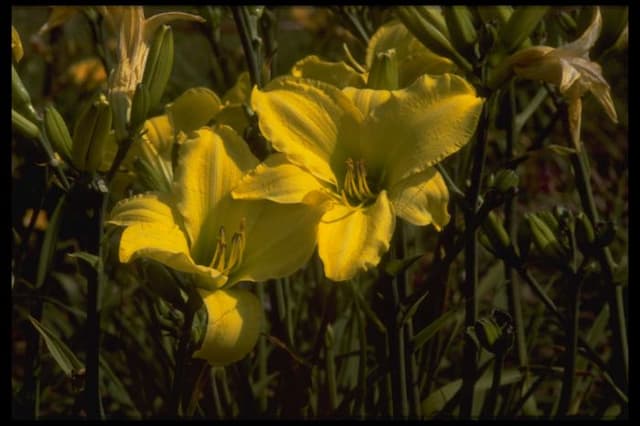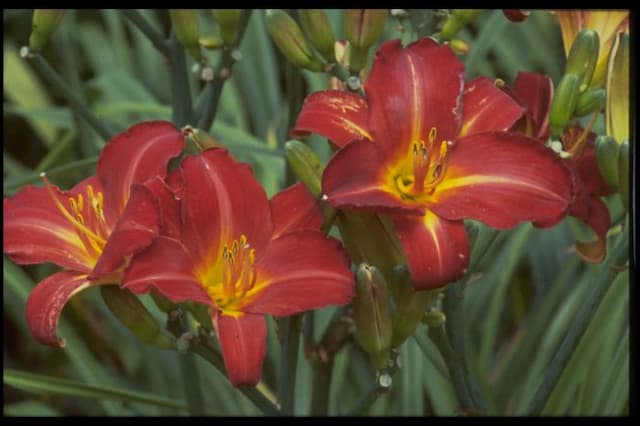Daylily Hemerocallis 'Bela Lugosi'

ABOUT
Hemerocallis 'Bela Lugosi' is commonly known as the Daylily, named for its day-long bloom duration. This particular variety is celebrated for its striking flowers, which exhibit deep, rich purple petals. Each petal has a velvety texture and often boasts a slightly ruffled edge, enhancing the flower's visual interest. The blossoms comprise of six broad, triangular petals that converge to form a funnel shape, surrounding a contrasting chartreuse to golden throat. The foliage of the Daylily 'Bela Lugosi' consists of long, arching, strap-like leaves that are grass-like in appearance. These leaves emerge from a clump at the base of the plant, creating a lush, green backdrop for the dramatic blooms. The leaves are bright green and may have a slightly ribbed texture, which adds an extra dimension to the plant's appearance. This particular daylily is a perennial favorite, returning year after year with its showy blooms that stand out in garden borders or beds. Its flowers appear atop tall, sturdy stalks that stand erect and are capable of holding the blooms high without the need for staking. The flowers are often described as having a glistening sheen when sunlight strikes their surfaces, making them a remarkable sight in the landscape. The Daylily 'Bela Lugosi' is a delight in any garden, offering a pop of dramatic color against the background of its verdant foliage.
About this plant
 Names
NamesFamily
Hemerocallidaceae
Synonyms
Daylily
Common names
Hemerocallis 'Bela Lugosi'.
 Characteristics
CharacteristicsLife cycle
Perennials
Foliage type
Deciduous
Color of leaves
Green
Flower color
Purple
Height
3 feet (0.91 meters)
Spread
2 feet (0.61 meters)
Plant type
Herb
Hardiness zones
3
Native area
Asia
Benefits
 General Benefits
General Benefits- Aesthetic Appeal: The Hemerocallis 'Bela Lugosi', commonly known as Daylily, features striking purple blooms that add dramatic color and visual interest to gardens.
- Low Maintenance: Daylilies are known for their hardiness and demand very little attention, making them ideal for busy gardeners and those new to gardening.
- Drought Tolerance: Once established, Daylilies can tolerate periods of drought, reducing the need for frequent watering.
- Pest Resistance: They are generally resilient to pests and diseases, minimizing the need for chemical treatments.
- Attracts Pollinators: The vibrant flowers of the Daylily attract butterflies and bees, which are beneficial for pollination.
- Versatility: Daylilies can be planted in a variety of garden settings, including borders, beds, and containers, and can adapt to different soil types.
- Long Bloom Period: Daylilies have a long flowering period, with blooms typically lasting just one day but new flowers opening up over several weeks.
- Erosion Control: Their root systems can help stabilize soil and prevent erosion on slopes and in garden beds.
- Easy Propagation: Daylilies are easy to propagate through division, allowing gardeners to expand their garden or share with others without additional cost.
- Suitable for Different Climates: Daylilies are versatile and can thrive in a range of climates from USDA hardiness zones 3 to 9.
 Medical Properties
Medical PropertiesThis plant is not used for medical purposes.
 Air-purifying Qualities
Air-purifying QualitiesThis plant is not specifically known for air purifying qualities.
 Other Uses
Other Uses- The daylily 'Bela Lugosi' can be used in homemade dyes for fabrics, providing a range of natural colors depending on the mordant used.
- Gardeners might plant daylilies like 'Bela Lugosi' to create a natural fence or border that adds aesthetic appeal while delineating property lines.
- These daylilies can serve as organic mulch when their leaves and stems are cut and left to decompose, enriching the soil with nutrients.
- Daylily petals of 'Bela Lugosi' are edible and can be used to add a colorful touch to salads and desserts.
- They can act as a natural pest deterrent when planted strategically, as some insects don't favor daylilies and will stay away.
- The robust root system of 'Bela Lugosi' helps in soil erosion control, especially on sloped landscapes.
- Daylily buds and blossoms can be used in floral crafts such as making potpourri or natural flower arrangements for home decor.
- These plants can be used in companion planting to help improve the growth of certain vegetables by attracting beneficial insects or providing shade.
- The decomposed material from daylilies, including 'Bela Lugosi', can be added to compost piles to enrich the content.
- Photographers and artists may use the striking appearance of 'Bela Lugosi' daylilies as subjects or inspiration for their work.
Interesting Facts
 Feng Shui
Feng ShuiThe Daylily is not used in Feng Shui practice.
 Zodiac Sign Compitability
Zodiac Sign CompitabilityThe Daylily is not used in astrology practice.
 Plant Symbolism
Plant Symbolism- Daylily – Transience: The name Hemerocallis comes from Greek words meaning "beauty" and "day," as each flower typically only lasts for a day, symbolizing the fleeting nature of life, beauty, and time.
- Daylily – Motherhood and Fertility: In Chinese culture, daylilies are associated with motherhood and reproduction due to their ability to produce numerous flowers over a short period.
- Daylily – Forgetfulness and Losing Worries: Eating the daylily buds is believed to help forget worries, and the plant is sometimes associated with forgetfulness because the flowers last for such a short time.
 Water
WaterDaylilies, including the 'Bela Lugosi' cultivar, need consistent moisture, especially during the growing season. Water the plant deeply once a week, providing about 1 to 1.5 inches of water each time, which correlates to approximately 0.625 to 0.94 gallons for an average-sized plant. The soil should be allowed to dry between watering to discourage rot but should not become completely dry. Pay special attention to watering during dry spells. More frequent watering may be necessary if your daylily is planted in sandy soil or during particularly hot, dry periods.
 Light
LightDaylilies, such as 'Bela Lugosi', thrive in full sunlight, which means at least 6 hours of direct sunlight per day. They can tolerate partial shade, but blooming may not be as prolific. The ideal spot for a 'Bela Lugosi' daylily is an area with morning sunlight and some afternoon protection in hotter climates. If you live in an area with very strong and hot sunlight, providing afternoon shade will help prevent the leaves from scorching.
 Temperature
TemperatureDaylilies, including 'Bela Lugosi', are very adaptable regarding temperature and can survive in USDA zones 3 through 9, accommodating a wide range from roughly -40°F to 90°F. However, the ideal growing temperatures for daylilies are between 50°F and 80°F, which provide the optimal environment for growth and flowering. These plants are robust and can withstand seasonal temperature fluctuations well.
 Pruning
PruningFor the 'Bela Lugosi' daylily, pruning is important to remove dead foliage and spent flower stalks, which encourages reblooming and maintains plant health. This is typically done in late fall or early spring. Deadheading, or removing old blooms, can be done throughout the blooming season to keep the plant tidy and promote further flowers. Cutting back the foliage in late fall after it has died back helps prevent disease and makes the garden look neater during the winter.
 Cleaning
CleaningAs needed
 Soil
SoilThe best soil mix for Daylilies (Hemerocallis 'Bela Lugosi') is well-draining, fertile, and slightly acidic to neutral, with an ideal pH range of 6.0 to 7.0. A mix of two parts loam, one part peat moss, and one part perlite or sand can create the ideal growing conditions.
 Repotting
RepottingDaylilies typically do not need to be repotted as they are generally grown outdoors. However, if grown in containers, repotting every three to four years or when they outgrow their current space is sufficient.
 Humidity & Misting
Humidity & MistingDaylilies are not particularly humidity sensitive and can thrive in the average outdoor humidity levels found in their suitable growing zones. They do well in both low and high humidity environments.
 Suitable locations
Suitable locationsIndoor
Ensure bright indirect light, consistent moisture, and good air circulation.
Outdoor
Plant in full sun to part shade, in well-draining soil.
Hardiness zone
3-9 USDA
 Life cycle
Life cycleThe life of the Daylily 'Bela Lugosi' begins with seed germination, typically occurring in moist, well-drained soil and warm temperatures. Once the seedling emerges, it develops into a young plant with strap-like foliage and establishes a robust root system. As it matures, the Daylily 'Bela Lugosi' produces a clump of green leaves and a scape, or flower stalk, which gives rise to multiple purple flower buds in the early to mid-summer. These buds bloom into large, vibrant purple flowers with a contrasting golden throat, each blossom lasting just one day. After the flowering period, the plant sets seed if pollination has occurred, and as the growing season ends, it enters a dormancy phase, with the foliage dying back in colder climates. Upon the return of favorable conditions, the Daylily 'Bela Lugosi' resumes growth from the rhizome, repeating the cycle annually.
 Propogation
PropogationPropogation time
Late summer to early fall
The Hemerocallis 'Bela Lugosi', commonly known as the 'Bela Lugosi' Daylily, is typically propagated through division. This is best done after the plant has finished flowering, usually in late summer to early fall. The process involves digging up the plant and carefully separating the clumps into smaller sections, each with a few leaves and a portion of the root system. These sections can then be replanted immediately in well-prepared soil, spaced about 18 to 24 inches (approximately 45 to 60 centimeters) apart to allow for growth and spread. Water the new plants well to help establish their roots in their new location.









